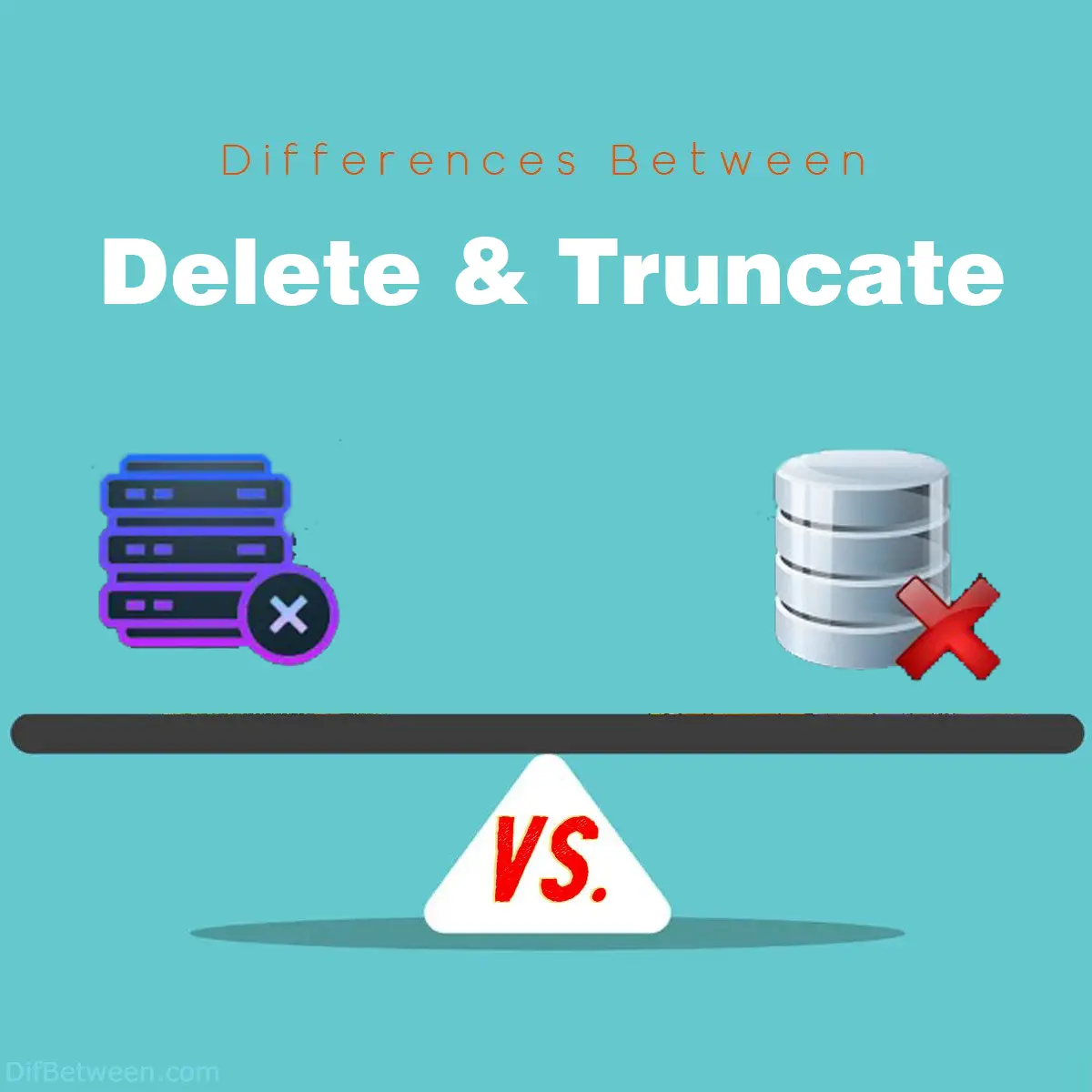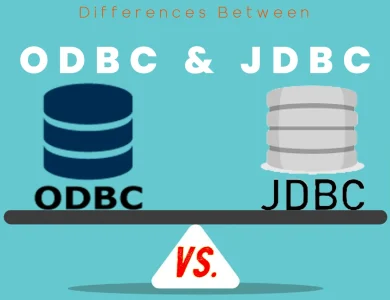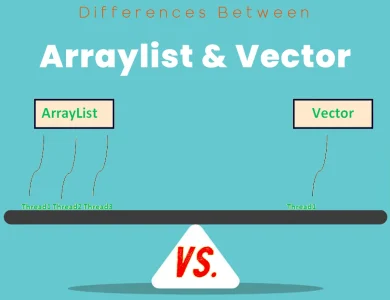
| Aspect | DELETE | TRUNCATE |
|---|---|---|
| Purpose | Used to remove specific rows from a table based on conditions. | Used to remove all rows from a table or reset a table entirely. |
| Operation Type | Row-level operation, more granular. | Table-level operation, more sweeping. |
| Table Structure | Leaves the table structure unchanged. | Resets the table structure (including auto-incremented IDs) to initial state. |
| Speed | Slower due to individual row processing and associated triggers/index updates. | Faster due to bulk removal and fewer associated actions. |
| Transaction | Can be used within a transaction to allow rollback of changes. | Typically does not support easy rollback; irreversible action. |
| Logging | Generates more log entries due to individual row deletions. | Generates fewer log entries due to bulk removal. |
| Data Recovery | Deleted data can be potentially recovered if transaction logs are available. | Generally no easy recovery method available. Requires backups. |
| Indexes | Requires additional work to update indexes as rows are deleted. | Minimal index updates due to bulk removal, improving performance. |
| Foreign Keys | Can be constrained by foreign key relationships, potentially requiring CASCADE actions. | Foreign key constraints are not directly affected. |
| Triggers | Triggers can be fired for each deleted row. | Triggers can be disabled to speed up the process. |
| Memory Usage | Might require more memory for processing individual deletions. | Requires less memory due to bulk removal nature. |
| Usage Scenarios | Used when precision is essential, or when maintaining data history is important. | Ideal for quickly clearing out entire tables or optimizing performance. |
| Backup | May require fewer backups since data can be selectively deleted. | Backup strategy should consider the irreversibility of the operation. |
| Examples | DELETE FROM employees WHERE salary < 1000; | TRUNCATE TABLE employees; |
Have you ever found yourself pondering over the differences between the DELETE and TRUNCATE commands in a database? Well, wonder no more! Let’s dive into the fascinating realm of data manipulation and uncover the key distinctions between these two SQL powerhouses.
Differences Between Delete vs Truncate
The main differences between DELETE and TRUNCATE lie in their precision and scope. DELETE allows selective removal of specific rows based on conditions, ensuring data integrity and historical preservation. In contrast, TRUNCATE swiftly clears entire tables without conditions, offering speed and efficiency but sacrificing easy data recovery and rollback options. The choice hinges on whether surgical precision or sweeping efficiency is paramount for your data manipulation needs.
The Purpose Behind Their Actions
DELETE: When Precision Matters
Ah, the DELETE command – a precision instrument in the database maestro’s toolkit. Imagine you’re cleaning out your closet, carefully selecting each item you want to bid farewell to. Similarly, DELETE allows you to selectively remove rows from a table based on specific conditions. It’s like Marie Kondo-ing your data, sparking joy by keeping only what you truly need. This precision comes at a cost, though – the database has to locate each row and apply the deletion operation, which might slow things down when dealing with a massive dataset.
TRUNCATE: Swift and Efficient
Now, imagine you’re decluttering your room with a massive sweep – that’s where TRUNCATE comes into play. This command is like a magic wand that swiftly clears out entire tables without much fuss. TRUNCATE doesn’t bother with individual rows or conditions; it just resets the table, leaving no trace of the old data. Since it’s less resource-intensive than DELETE, it’s blazingly fast, making it a top choice when you want to nuke a table and start afresh.
The Impact on Table Structure
DELETE: Rows Go Bye-Bye
When you DELETE rows from a table, the structure of the table remains untouched. It’s like removing specific books from your shelf – the shelf stays intact, but there are empty spaces where the books used to be. The table’s auto-incremented ID, for instance, keeps on counting without a care in the world. This can be handy when you want to keep historical records or maintain data integrity.
TRUNCATE: Resetting the Table, ID and All
TRUNCATE takes a more drastic approach. It not only removes all the rows but also resets the auto-incremented ID back to its initial value. Think of it as taking all the books from your shelf, tossing the shelf itself, and replacing it with a shiny new one. This might save you some storage space and make your database performance happier, but say goodbye to any historical data or references relying on those IDs.
Speed vs. Safety: Performance Considerations
DELETE: Deliberate and Slower 🐢
Remember the precision we talked about? Well, it comes at a price – DELETE operations can be slower, especially on larger datasets. Each row deletion requires the database to execute multiple actions, including logging each deletion (in case you want to roll back) and updating indexes. If you’re worried about maintaining referential integrity and triggers, DELETE has your back.
TRUNCATE: Like a Database Reboot 🚀
TRUNCATE sweeps through the table at lightning speed. It’s like flipping a table and watching all the data disappear in an instant. Since TRUNCATE doesn’t generate as many log entries and doesn’t involve indexes and triggers, it’s significantly faster than DELETE. However, the simplicity comes at a cost – if you’re not careful, you might accidentally erase all your precious data, and there’s no going back!
Rollback and Recovery
DELETE: Transactions and Safety Nets 🎭
When you DELETE, the database is your safety net performer. All your deletions can be wrapped within a transaction, allowing you to roll back if things go awry. It’s like rehearsing a play – if one scene doesn’t go as planned, you can always call for a retake. This way, you can avoid the horror of unintentionally deleting data permanently.
TRUNCATE: No Turning Back ⏳
With TRUNCATE, there’s no easy way to undo the magic. Once that command is executed, it’s like releasing a genie from the bottle – there’s no putting it back in. Transactions won’t save you here; you can’t roll back a TRUNCATE operation. So, make sure you’ve got proper backups before hitting that button!
Scope of Application
DELETE: The Precision Tool 🔍
DELETE is your go-to choice when you need to surgically remove specific rows based on conditions. It’s perfect for when you want to keep certain records intact while bidding adieu to others. Think of it as a scalpel – precise, but not ideal for a full-blown cleanup.
TRUNCATE: The Cleanup Crew 🧹
TRUNCATE shines when you’re in a hurry to tidy up and don’t need to worry about specifics. It’s fantastic for when you’re refreshing a temporary table or wiping out a log. Picture it as a magical broom, sweeping away all the mess in one fell swoop.
To Sum it Up
Alright, data adventurer, we’ve taken a whirlwind tour through the realms of DELETE and TRUNCATE commands in the database world. Let’s recap the main takeaways:
DELETE: When precision is paramount and you need to selectively bid adieu to specific rows based on conditions, DELETE is your trusted sidekick. It’s like carefully removing puzzle pieces to create a clearer picture.
TRUNCATE: For those times when you’re in a hurry to make space and efficiency is your goal, TRUNCATE is the magic spell you need. It swiftly clears out entire tables, making your database look brand new.
Remember, it’s not a battle of “good vs. evil” or a choice between “right and wrong.” Each of these commands has its own unique strengths, and the choice depends on your specific needs and circumstances.
Delete Or Truncate : Which One is Right Choose for You?
Are you standing at the crossroads, wondering whether to dance with DELETE or tango with TRUNCATE in your database adventure? Fear not, for we’re here to help you unravel the enigma and make an informed decision that aligns with your data needs.
The Case for DELETE: Surgical Precision
DELETE – ah, the surgeon’s scalpel of database operations! If you find yourself in a scenario where precision is key, DELETE might just be your trusty sidekick. Picture this: you’re sorting through a deck of cards, meticulously selecting the ones you want to keep while letting go of the others. Similarly, DELETE lets you surgically remove specific rows based on your defined conditions. It’s all about fine-tuning and retaining control.
When to tap into the DELETE magic:
- You need to selectively remove certain rows while keeping others intact.
- Your goal is to maintain historical records or preserve data integrity.
- You’re comfortable with a slightly slower operation, as long as every move is calculated.
The Charms of TRUNCATE: Swift and Sweeping
TRUNCATE – the wizard’s wand in your database realm! Imagine stepping into a room and with a single wave, seeing everything transformed into a clean slate. That’s TRUNCATE for you – a swift, no-nonsense approach to wiping the slate clean. It’s like a magic broom, sweeping away all the clutter in one fell swoop. When you’re in a hurry to tidy up and specifics aren’t your concern, TRUNCATE is your go-to.
When to wield the TRUNCATE wand:
- You want to swiftly reset an entire table, perhaps in preparation for fresh data.
- Speed and efficiency are your top priorities, and you’re not worried about retaining historical data.
- You’re willing to forgo the option of easy rollback and recovery in exchange for lightning-fast action.
The Decision-Making Process
Choosing between DELETE and TRUNCATE is like selecting the right tool for the job:
- DELETE is your chisel – precise, calculated, and perfect for sculpting the data landscape. Use it when you need to keep certain elements while removing others with surgical accuracy.
- TRUNCATE is your eraser – quick, efficient, and ready to wipe the slate clean. Opt for it when you’re ready to bid farewell to all the data in a table without a second thought.
Remember, both options have their strengths and caveats. As you stand before this data crossroads, consider factors like your data retention needs, the potential for data recovery, and the performance implications. Choose wisely, and may your data endeavors be filled with insight and efficiency!
FAQs
The primary distinction lies in their approach: DELETE removes specific rows based on conditions, while TRUNCATE clears entire tables swiftly. DELETE offers precision, while TRUNCATE prioritizes efficiency.
No, TRUNCATE is irreversible and typically doesn’t support rollback within transactions. It’s crucial to have proper backups before using TRUNCATE.
Use DELETE when you need to selectively remove specific rows while keeping others intact, maintaining data integrity, or retaining historical records.
TRUNCATE is ideal when you want to swiftly clear out entire tables, prioritize performance and efficiency, and don’t need to worry about data recovery or rollback.
DELETE leaves the table structure unchanged, whereas TRUNCATE can reset the table structure, including auto-incremented IDs.
TRUNCATE is generally faster due to its bulk operation nature and fewer associated actions like logging and index updates.
Yes, DELETE can be used within transactions, allowing rollback if needed. TRUNCATE is typically not rollback-friendly, as it’s an irreversible action.
TRUNCATE may involve fewer index updates and trigger firing, making it faster. However, indexes and triggers are not directly removed by TRUNCATE.
The main risk is its irreversibility. Once executed, TRUNCATE permanently removes all data, and there’s no easy way to recover it. Always have reliable backups.
Consider your priorities: choose DELETE for precision and data retention, and TRUNCATE for speed and sweeping cleanups. Assess your data needs and recovery options.
Read More :
Contents






